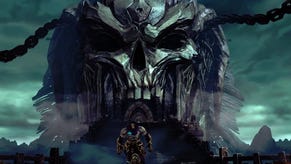Red Faction: Armageddon
My sickle friend.
"They don't call it the red planet for nothing," Darius Mason growls. Indeed not, Darius – according to our extensive research on Wikipedia, they are in fact referring to the prevalence of iron oxide on the planet's surface.
Our hero, however, is probably referring to all the bloodshed and carnage wrought by successive generations of EDF, Marauders and the rebellious Red Faction. They have been going at it ostrich hammer and tong since the days of the Emotion Engine, and enjoyed solid success with 2009's Red Faction: Guerrilla.
At the outset of Red Faction: Armageddon, Mason's buddies find themselves painting the streets even redder. They're racing to repel destructive incursions from the cultist forces of a pasty weirdo known as Adam Hale (no relation to Resistance's Nathan Hale, presumably, although along with Mason they are all subscribers to the bald-headed space marine school of sci-fi fashion).
Hale and his followers are trying to shut down the Terraformer – a gigantic, City 17 Citadel-style tower that is slowly driving Mars towards a bright future of green space, fluffy clouds and Nectar points – and its removal would be fairly bad news for the population.
Naughty old Hale presumably enjoys some success, because the three sections of Armageddon we get to play (and indeed the game's title) make it clear that things don't go terribly well for Mason from thereon in.
A generation of Mars-dwellers is forced underground to avoid the hostile surface conditions, and after receiving some duff advice Mason manages to compound their gloomy misery by unleashing the spiky members of a dormant alien species (who appear to have been hibernating in Dead Space). They sprout from giant claw-like extrusions and scuttle and clamber around caverns, ripping people apart.

Developer Volition and "transmedia" obsessed THQ will be hoping that you find these events more compelling than you did with Guerrilla. Apparently storytelling was something that punters singled out for criticism last time around, and by way of compensation characters will be more rounded and events more elegantly represented.
There are also plans firmly in motion for a Syfy channel spin-off movie, which should air at the same time the game comes out. But the game's creators are very conscious of what worked in Red Factions gone by – most notably the GeoMod destruction technology that underpins all the in-game buildings, allowing them to fall apart in weighty and spectacular fashion.
From that perspective, the most exciting thing about Armageddon at the moment is the magnet gun. Last time it was the remote-detonation explosive charges. Remember the thrill every time you upgraded your remote charge capacity, and how merrily you strode out into the world in search of things to mine a little more elaborately?
The magnet gun sparks similar feelings. Not unlike Just Cause 2's two-ended grappling hook, it allows you to introduce objects to one another at high speed. You fire one magnet at one thing and then the other at another thing, and thing one is propelled toward thing two at high velocity.
In combination with GeoMod, though, the possibilities are more numerous and exotic. You can fire an alien at a building, and rather than just banging heavily into it and expiring, it will generally smash through the wall and then expire - hopefully bringing the structure down in the process. Fire a magnet at the wall of a house and another at a smokestack, and a chunk of the wall will separate itself and hurtle thrillingly across the screen.
The only non-campaign level we get to play is a tech-demo playground of buildings, walkways, chimneys and overpasses. It's telling that we spend more time happily playing with the magnet gun in these surroundings, without the hassle of objectives, than we do gunning through the early stages of the story.






